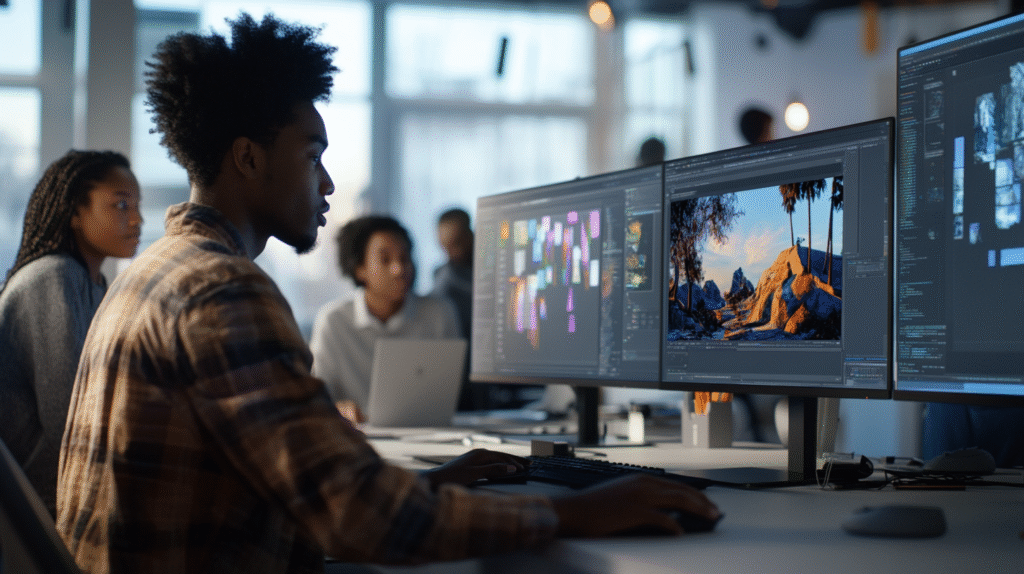Imagine this: It’s the golden age of animation, and an artist hunches over a desk, meticulously sketching each frame by hand. Every movement, every line, every flicker of expression is carefully drawn, turning individual frames into fluid sequences that make us laugh, cry, and cheer. This was animation’s heartbeat—crafted by hand, frame by frame. Now, fast-forward to today, where technology has not only streamlined the process but unlocked endless possibilities. The future of animation is an exciting blend of tradition and innovation, a mix of nostalgia and novelty, where hand-drawn art meets cutting-edge digital tools to bring worlds beyond our imagination to life.
You might think, “What’s left to innovate? We’ve already got lifelike characters, epic worlds, and mind-bending effects.” But animation is just getting started. Much like the Game Changers (40s) in the Brilliant List, animation is continuously redefining itself, pushing boundaries and evolving with each new technological leap. It’s a field that’s not afraid to adapt, learn, and grow—traits we can all appreciate, no matter where we are on our journey.
The Leap from Paper to Pixels
Let’s talk about the shift from traditional, hand-drawn animation to digital animation, a transition that revolutionized the industry. Traditional animation required artists to draw each frame by hand—tedious, yes, but there was magic in those brushstrokes. Today, digital animation tools allow artists to create in ways the pioneers of animation could only dream of. Software like Blender, Adobe After Effects, and Toon Boom Harmony have transformed the animator’s toolkit, making the process faster, more accessible, and, let’s be honest, way cooler.
Digital tools mean that creators can bring worlds to life with fewer limitations. Have you noticed how the quality of animated films and series has skyrocketed? That’s the power of digital animation. And it’s not just for big studios; even indie creators and up-and-coming Visionaries (30s) are using these tools to tell stories and break into the industry without needing a million-dollar budget. Today, anyone with a computer and a creative spark can become an animator, making the industry more vibrant and inclusive than ever before.

Mixing Mediums: The Best of Both Worlds
The future of animation doesn’t mean leaving traditional art behind. In fact, many animators are revisiting and combining classic techniques with digital magic, creating a “best of both worlds” scenario. Hybrid animations—where hand-drawn elements meet CGI—give animations a rich, textured feel. Take the animated masterpiece Spider-Man: Into the Spider-Verse, which blended comic book aesthetics with CGI. This mix of styles took audiences by storm and reminded everyone that animation can be anything you want it to be.
This approach is very much in line with the trailblazing spirit of the Brilliant List’s Difference Makers (50s) category, who show us the importance of blending experience with innovation. Combining techniques from past and present allows animators to add depth and character, resulting in visuals that are not only stunning but resonate emotionally, connecting us to the story in unexpected ways.
AI and Animation: The Next Frontier
Now, we know what you might be thinking: “Is AI taking over animation, too?” The short answer: AI is certainly helping, but it’s here as a sidekick, not a replacement. AI is streamlining workflows, generating backgrounds, and even helping animators create complex character movements with minimal effort. But don’t worry—AI isn’t about to replace human creativity. In fact, it’s enhancing it, allowing artists to focus more on the creative side and less on the technical heavy lifting. AI-powered tools are a bit like the Notable Newcomers (Teens) on the Brilliant List—full of potential and ready to change the game while working alongside the experts.

The Rise of Interactive Animation
Interactive animation is perhaps the most exciting frontier. Imagine a world where you’re not just watching a story unfold—you’re part of it. Animation is increasingly incorporating interactivity, whether it’s through VR, AR, or choose-your-own-adventure experiences. This gives viewers agency, making them an active participant in the story. Think of it as the ultimate form of engagement, a nod to the Brilliant List’s Movers & Shakers (20s), who are all about breaking boundaries and embracing new experiences.
What This Means for You
So, what does this all mean for you, dear reader? Whether you’re an animation enthusiast, an aspiring artist, or someone who simply enjoys a good story, the future of animation has something for everyone. It’s an industry that continues to surprise, innovate, and evolve—just like you. As technology grows, so do the opportunities to tell richer, more diverse stories. So, get ready, because the next era of animation is a brilliant blend of the familiar and the fantastic, where old and new techniques collide to create something truly magical.
And who knows? You might just be inspired to pick up a pencil—or a stylus—and become part of the next wave of digital masterpieces. Because the future of animation isn’t just for the studios or the experts; it’s for everyone with a story to tell. Just like the Brilliant List, the animation world is a place where anyone, at any age, can make their mark.


